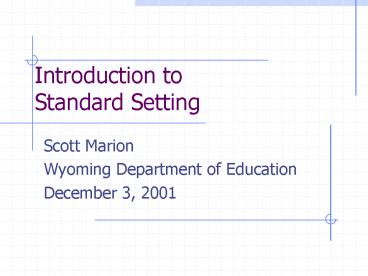Introduction to Standard Setting PowerPoint PPT Presentation
1 / 25
Title: Introduction to Standard Setting
1
Introduction to Standard Setting
- Scott Marion
- Wyoming Department of Education
- December 3, 2001
2
Overview of the day
- Introduction to standard-setting
- Overview of two methods
- Work through examples for two methods
- Q A
3
Introduction
- Our task is to use a deliberative process to
identify points along a continuum to classify
student performance into multiple categories - Standard setting is controversial, but it is
almost always better than using traditional
percentages (e.g., 80) - Safest road is to ensure certain fundamental
procedures are followed - Documenting your approach will help you in the
long run (and even the short run)
4
Important Distinction
- Standard-setting panels do not set standards
they are at least one form of input, albeit an
important one, into the standard-setting process. - Your Board or a group sanctioned by your Board,
using the evidence it sees fit, sets the
standards. It will be evaluated on whether it
used appropriate input in a reasonable fashion.
5
It all starts with the performance descriptors
- Standard setting is the process of putting
specific meaning on these general statements. - If the performance descriptors change, you have
to restart the process, because the descriptors
have a great deal of influence on where the
cutscore score are established. - If you make general statements more specific, you
constrain the standard-setting panels.
6
Performance descriptors
- In Wyoming, we need to generate performance
descriptors based on the performance standards in
the Wyoming Content and Performance Standards
(you can just adopt the state standards). - The descriptors need to be written for either the
standard level or the content area level (the
minimum requirement).
7
Classes of Standard-Setting Procedures
- Focus on
- Tasks/Items (Angoff, Bookmark)
- Examinees (Contrasting Groups, Teacher Judgment,
Borderline) - Examinee responses (Body of Work)
- Scored performances (Profiles)
- All of these were designed to set standards on
single testsmost are not adaptable for a
complete BOE system.
8
Standard Setting Methods You Are Most Likely to
Use
- Body of Work
- Contrasting Groups/Teacher Judgment
- Borderline Groups
9
Focus on Examinee ResponsesBody of Work
- Select work from a range of students
- Have panel determine which students are above
standard and which are below, on the basis of the
work shown - More details later
10
Combining judgments
- Ultimate goal is a pass/fail decision on each
student in each content area - Separate standard-setting process for each
content area, but it might be easier to set
standards for each content standard and then
integrate judgments - Can combine parts through Body of Work or profile
methods - Standards across content areas should be
consistent at least according to expectations of
performance
11
Focus on ExamineesContrasting Groups
- Administer assessments
- Identify proficient and non-proficient
- Select score that puts most proficient students
and fewest non-proficient students above that
score
12
Focus on ExamineesContrasting Groups
Non-Proficient
Proficient
Cut Score
13
Dilemma with Contrasting Groups
Masters
Non-Masters
Cut Score
14
Dilemma with Contrasting Groups
Percentage of Non-Masters
Masters
Number of Non-Masters
Where Should the Cut Score Go?
15
Focus on ExamineesTeacher Judgment Method
- Collect judgments of performance for a sample of
students-tied closely to performance descriptors - Associate judgments with scores on set of
assessments - Select score that puts most students in upper
category and fewest students in lower category
above that scorethe same procedure as
contrasting groups
16
Focus on ExamineesBorderline Group Method
- Administer assessments
- Identify borderline candidates
- Select an average score for borderline candidates
- Place cutscore
17
Focus on ExamineesBorderline Group
Borderline Candidates
18
Focus on ExamineesBorderline Group
Borderline Candidates
Cut Score
19
Selecting Panelists
- Number
- Composition
- Stakeholders (i.e., your Board)
- Experts
- Public
- Represented constituencies
- Process for selecting each panelist
- Motivation for participating
- Sub-panels
- Homogeneous vs. heterogeneous
- Qualification decisions
20
Training
- Background, purpose
- Definitions
- Content standards
- Performance standards
- Distinction between panelist and policy-maker
- Practice with authentic materials, i.e., student
work
21
Options to Choose
- Composition of panel
- Size
- Experts vs. stakeholders
- Homogeneous vs. designed heterogeneity
- Training of panel
- Focus on gaining an operational understanding of
the descriptors - Calibration of panelists to develop consistency
in ratings
22
Options to Choose (contd)
- Degree of independence of panelists judgments
- Number of iterations
- Amount of material to show panelists
- Timing and amount of feedback
- Summarization procedures
23
Checking Validity
- Consistency across content areas
- Consistency with qualified judgments
- Consistency with external measures, e.g.,
national or state tests
24
Checking Reliability
- Numbers of panelists
- Different samples of student work
- Different standard-setting procedures
- Different types of panelists
- Different definitions of mastery
- Different feedback provided
25
Documentation
- This will be important for
- Review and feedback
- Potential legal challenges
- Consistency of program in cases of personnel
turnover

